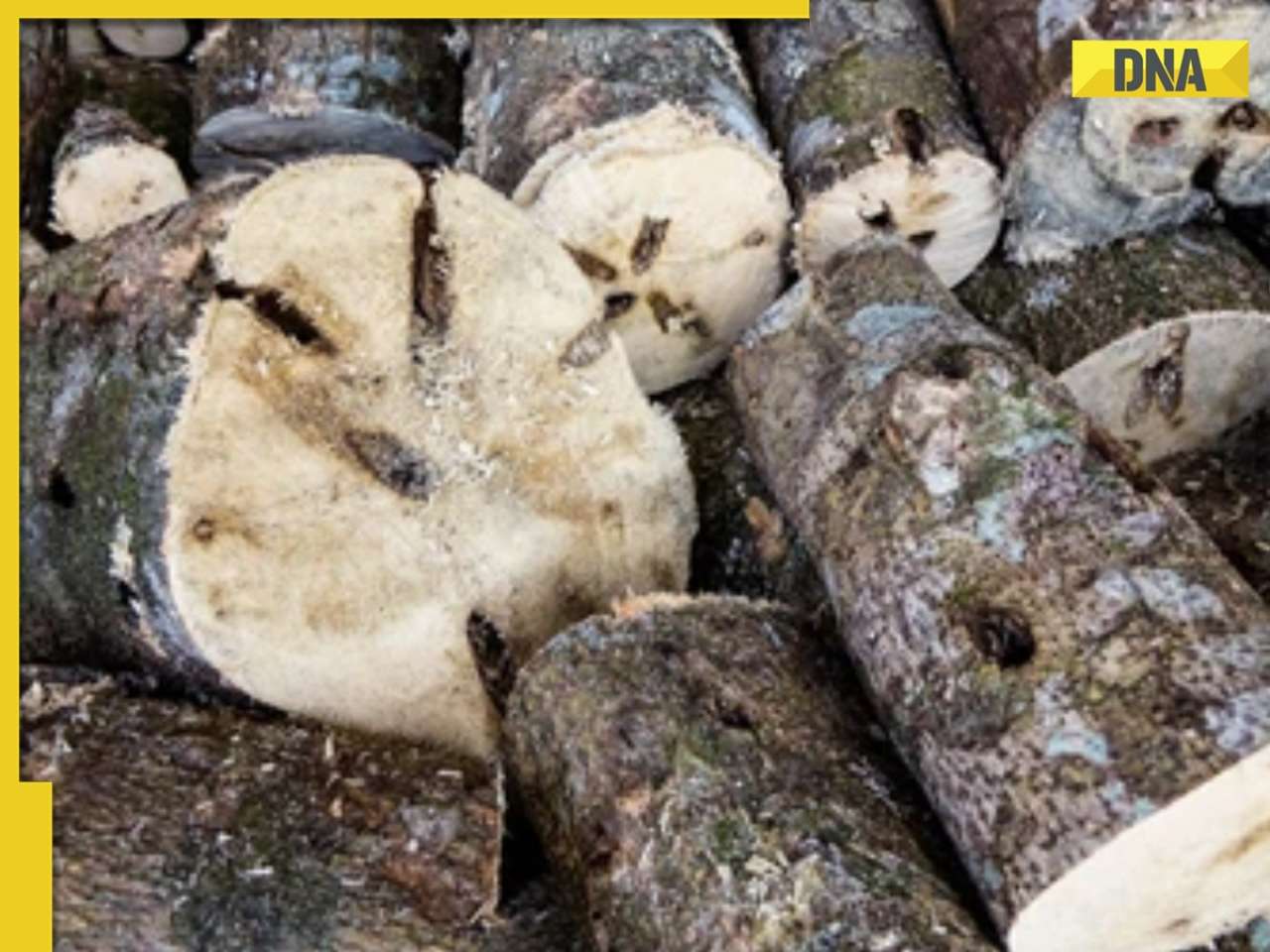The baobab's unusual name, Hatiyan Jhar, comes from the Hindi word "Haathi Vriksh", which alludes to its thick, crooked trunk that twists and arcs like an elephant in motion.
Inside the Hyderabad Golf Club lies hidden one of the city's most extraordinary botanical and historical landmarks - the centuries-old Hatiyan Jhar baobab tree, which is believed to have originated from Madagascar and was brought to India by Arab traders. Famous for its massive trunk that resembles the body of an elephant, this iconic tree has become a cultural and ecological heritage in the City of Nizams.
The baobab's unusual name, Hatiyan Jhar, comes from the Hindi word "Haathi Vriksh", which alludes to its thick, crooked trunk that twists and arcs like an elephant in motion. The trunk has a huge hollow space with a circumference of 25 metres, enough to accommodate 40 people simultaneously.
According to a report by Local18, the tree stands out even from a distance, its twisted shape drawing the eyes and attracting curious onlookers. Many tourists describe it as both eerie and majestic. Nestled among ancient trees and near long-forgotten palaces, the area around Hathiyan Jhar has become a popular spot for both tourists and local families.
Protected monument status
The Hathiyan Jhar baobab tree is now in a protected enclosure inside the Hyderabad Golf Club, protected by the Archaeological Survey of India (ASI), local guide S Kumar told Local18. After environmental activists and residents raised concerns about possible damage and erosion, the ASI installed an iron fence around the tree. Given these concerns, the ASI officially declared the baobab a protected monument of national importance.
How to visit
The nearest metro station is the Jubilee Hills Check Post metro station, located about 3 km away. From there, autos and rickshaws are readily available to take visitors directly to the site.
Folklore claims that the tree was planted by an African traveller centuries ago, but this is yet to be authenticated. There is no concrete historical evidence of its arrival in Hyderabad, leaving its true origins shrouded in mystery.
Also read: This is world's most expensive Labubu doll, once priced at Rs 7000, now sold for whopping...
Find your daily dose of All
Latest News including
Sports News,
Entertainment News,
Lifestyle News, explainers & more. Stay updated, Stay informed-
Follow DNA on WhatsApp. SSC acts on student grievances during examinations, promises to act quickly
SSC acts on student grievances during examinations, promises to act quickly Sachin Tendulkar's daughter Sara Tendulkar gets new role, appointed as Rs 1140 crore...
Sachin Tendulkar's daughter Sara Tendulkar gets new role, appointed as Rs 1140 crore... India's first Vande Bharat sleeper train to be launched in...; top speed will be...; check details
India's first Vande Bharat sleeper train to be launched in...; top speed will be...; check details India's richest producer once sold toothbrushes, installed cable TVs, is worth Rs 13000 crore, has now won 5 National Awards
India's richest producer once sold toothbrushes, installed cable TVs, is worth Rs 13000 crore, has now won 5 National Awards IND vs ENG: India register narrowest win ever in Tests to level 5-match series against England
IND vs ENG: India register narrowest win ever in Tests to level 5-match series against England Eye Infection during monsoon: How to prevent them naturally?
Eye Infection during monsoon: How to prevent them naturally? 7 hidden triggers behind lung cancer in non-smokers across India
7 hidden triggers behind lung cancer in non-smokers across India 7 unique images of cosmology captured by NASA's Hubble Space Telescope
7 unique images of cosmology captured by NASA's Hubble Space Telescope 7 breathtaking images of Milky Way captured by NASA
7 breathtaking images of Milky Way captured by NASA Jeera water vs Saunf water: Which morning drink works better for you?
Jeera water vs Saunf water: Which morning drink works better for you? Exclusive: Jyoti Malhotra on Volvo XC60, New Launches & Volvo’s India Strategy | Volvo Car India MD
Exclusive: Jyoti Malhotra on Volvo XC60, New Launches & Volvo’s India Strategy | Volvo Car India MD Exclusive Interview: Rajeev Kapur on Steelbird’s New Helmets & Global Strategy!
Exclusive Interview: Rajeev Kapur on Steelbird’s New Helmets & Global Strategy! Futuristic Education: AI or Natural Intelligence, What's in focus? | Rajiv Tandon, BITS Pilani Digital
Futuristic Education: AI or Natural Intelligence, What's in focus? | Rajiv Tandon, BITS Pilani Digital Tata Harrier EV Review | Most Advanced Electric SUV from Tata?
Tata Harrier EV Review | Most Advanced Electric SUV from Tata? Vida VX2 Plus Electric Scooter Review: Range, Power & Real-World Ride Tested!
Vida VX2 Plus Electric Scooter Review: Range, Power & Real-World Ride Tested! Elon Musk-owned EV giant Tesla launches charging stations in THIS city, Know how much it will cost
Elon Musk-owned EV giant Tesla launches charging stations in THIS city, Know how much it will cost TCS layoffs signal Indian IT restructuring: How US uncertainty, AI disruption affect employees
TCS layoffs signal Indian IT restructuring: How US uncertainty, AI disruption affect employees Godfather of AI issues CHILLING warning about chatbots: 'It gets more...'
Godfather of AI issues CHILLING warning about chatbots: 'It gets more...' Elon Musk's Tesla rival VinFast opens largest India showroom in THIS city, plans expansion to...
Elon Musk's Tesla rival VinFast opens largest India showroom in THIS city, plans expansion to... Meet man who rejected Rs 1.5 billion job offer from Mark Zuckerberg, now his startup is valued at..., check his viral LinkedIn story
Meet man who rejected Rs 1.5 billion job offer from Mark Zuckerberg, now his startup is valued at..., check his viral LinkedIn story  5 must-watch fashion films that styled our childhood dreams
5 must-watch fashion films that styled our childhood dreams 7 Indian biopics that brought political leaders to life
7 Indian biopics that brought political leaders to life Before Ranveer Singh’s Dhurandhar hits screens, take a look at actor’s 5 iconic roles that prove his versatility
Before Ranveer Singh’s Dhurandhar hits screens, take a look at actor’s 5 iconic roles that prove his versatility Amitabh Bachchan, Shah Rukh Khan, Ajay Devgn and more Bollywood actors who are proud owners of luxurious private jets
Amitabh Bachchan, Shah Rukh Khan, Ajay Devgn and more Bollywood actors who are proud owners of luxurious private jets Tamannaah Bhatia's 'gross but works' acne hack under dermatologist scanner, should you try it?
Tamannaah Bhatia's 'gross but works' acne hack under dermatologist scanner, should you try it? India's first Vande Bharat sleeper train to be launched in...; top speed will be...; check details
India's first Vande Bharat sleeper train to be launched in...; top speed will be...; check details This is India's most profitable expressway, took 22 years to build, earns Rs 163 crore annually, passes through these districts
This is India's most profitable expressway, took 22 years to build, earns Rs 163 crore annually, passes through these districts Will India remain defiant to Donald Trump's pressure on Russian oil? Has PM Modi emphasised 'swadeshi' to snub US?
Will India remain defiant to Donald Trump's pressure on Russian oil? Has PM Modi emphasised 'swadeshi' to snub US? Good news for Ghaziabad, Greater Noida Commuters: New flyover to ease Shahberi bottleneck, details here
Good news for Ghaziabad, Greater Noida Commuters: New flyover to ease Shahberi bottleneck, details here Ekadashi 2025: When to observe vrat in August? Know dates, shubh muhurat to seek divine blessings
Ekadashi 2025: When to observe vrat in August? Know dates, shubh muhurat to seek divine blessings Meet woman who lost her father, studied at Oxford, later cracked UPSC in first attempt to become IPS officer, she’s from...
Meet woman who lost her father, studied at Oxford, later cracked UPSC in first attempt to become IPS officer, she’s from... Meet man, who could not become IPS officer, later trained over 10000 underprivileged students for just Rs... to become IAS-IPS officers, he is...
Meet man, who could not become IPS officer, later trained over 10000 underprivileged students for just Rs... to become IAS-IPS officers, he is... BIG relief for patients as government cuts prices of 35 essential medicines, details here
BIG relief for patients as government cuts prices of 35 essential medicines, details here Meet woman who cracked UPSC exam four times, got AIR 31 but did not become IAS, IPS officer due to…, currently working as…
Meet woman who cracked UPSC exam four times, got AIR 31 but did not become IAS, IPS officer due to…, currently working as… Meet woman, an SRCC-graduate, one of the youngest female IAS officers who cracked UPSC at 21, she is...
Meet woman, an SRCC-graduate, one of the youngest female IAS officers who cracked UPSC at 21, she is... This is world’s longest car, has helipad, golf course, swimming pool; with over 75 seats, owned by THIS billionaire, not owned by Elon Musk, Mark Zuckerberg, Mukesh Ambani, Gautam Adani
This is world’s longest car, has helipad, golf course, swimming pool; with over 75 seats, owned by THIS billionaire, not owned by Elon Musk, Mark Zuckerberg, Mukesh Ambani, Gautam Adani Maruti Suzuki's e Vitara set to debut electric market at Rs..., with range of over 500 km, to launch on...
Maruti Suzuki's e Vitara set to debut electric market at Rs..., with range of over 500 km, to launch on... This is world’s most expensive wood, cost of 1kg wood is more than gold, its name is..., is found in...
This is world’s most expensive wood, cost of 1kg wood is more than gold, its name is..., is found in... This luxury car is first choice of Indians, even left BMW, Jaguar, Audi behind in sales, it is...
This luxury car is first choice of Indians, even left BMW, Jaguar, Audi behind in sales, it is... Kia India unveils Carens Clavis: Check features, design changes, price and more; bookings open on...
Kia India unveils Carens Clavis: Check features, design changes, price and more; bookings open on...





)
)
)
)
)
)
)
)
)
)
)
)
)
)
)
)










